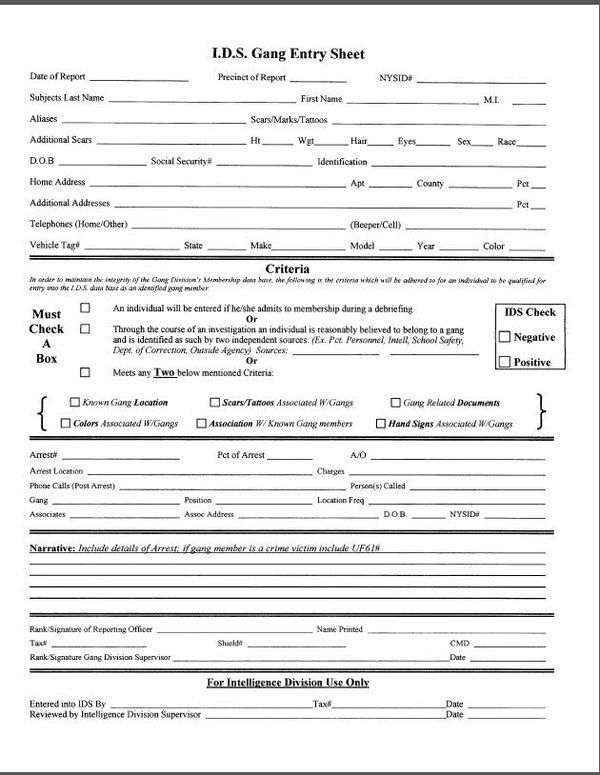As President Donald Trump has vowed to aggressively take on gangs across the country, sweeping anti-gang tactics may soon come under new scrutiny. One issues is the question of how the “gang” label is established. As it stands, law enforcement has vast discretion in making that distinction. However, data obtained through a freedom of information by CUNY Law’s Professor Babe Howell has already shed light on how the NYPD has established who’s in a gang. The loose criteria doesn't support boasts of "precision policing" coming from City Hall. In fact, it's likely that the city's gang takedown strategy has already done damage by sweeping up people minimally, or not even involved at all, in gang violence.
You are in a gang, according the NYPD's Intelligence Division, if you fit one of three sets of criteria. One, you admit to being in a gang. Two, you're identified as a gang member by other agencies, like the Department of Corrections. Three, any two of the following apply to you: having scars or tattoos cops say are gang-related, wearing colors or using signs associated with gangs, associating with gang members or living in a designated gang area. This flexible definition puts into focus claims over the past few years that people are being caught in a gang dragnet unfairly.
Simply living in police-designated gang turfs, like those illustrated in a map published by the New York Daily News last January, would mean you're halfway to being gangbanger in the eyes of the law. Wearing a certain color or associating with someone, even a friend or family member, could carry you the other half.

NYPD “Gang Entry Sheet” used to designate someone a gang member
Not only is this a recipe for discrimination and wrongful convictions; with cops and prosecutors enjoying unchallenged discretion, the net of suspicion can be as expansive as their imagination. Whomever associates with those thought to be in gang, perhaps through a handshake, are not only potentially caught in that net but also expand to it by bringing their social networks under suspicion as well. Last year, a California state auditor found that the state's gang database, CalGang, was so full of errors and unsubstantiated entries that it should be overhauled. In Portland, you don't even need to be arrested to land on their gang database.
This raises another problem: if gang designations are perhaps ill-defined, then gang violence data too may be malleable--and rife for abuse. What is or isn't gang violence is defined by who's in a gang. Giving the police department, which has massaged crime statistics in the past, the power to decide who's in a gang also gives it de facto control over gang data. This can allow for the police department to overstate the presence of gangs and, crucially, control the data we use to determine the efficiency of their tactics.
Leading up a 2014 gang raid in West Harlem, cops and prosecutors opened investigations into some young men when they were preteens. Most arrested and indicted in raids like these never see a trial due to the incredible leverage of conspiracy laws at the state level and Racketeering Influenced and Corrupt Organizations (RICO) laws at the federal level. Gang conspiracy is relatively easy to prove and the sentences are excessive. Limited legal resources mean that most take plea deals, often at the behest of their lawyers. The results are predictable: raids look successful because of the high rate of convictions. For those who risk going to trial, prosecutors rely heavily on social media, where claims of gang association are often based off of the posts and messages of teenagers. In Manhattan, Cy Vance's office has relied on software firm Palantir, a tech company started by eBay founder (and Donald Trump supporter) Peter Thiel, to analyze patterns of online behavior. Music lyrics were even used as evidence in a 2014 federal trial of an accused gang member.
Last April's gang takedown in the Bronx, the biggest raid in city history, saw the presence of multiple federal law enforcement agencies, including ICE'S Homeland Security Investigations unit. HSI is tasked with responding to "transnational" gangs. In New York, which doesn't have the gang presence found in other cities, most, if not all, alleged "gang" members have likely never left the country. One young man arrested in the Bronx last year was working at Whole Foods Market at the time of the raid. He is now facing charges more appropriate for a member of the Gambino crime family. And, as City Lab’s George Joseph reported today, HSI were quite pleased with the media coverage that takedown received (which is another issue).
For New Yorkers opposed to the Trump administration's call for increased deportations, one has to ask what the endgame is for communities of color in New York. ICE raids for immigrant communities and 'gang' raids for Black communities screams of a racial cleansing effort. For alleged members Latin American oriented gangs, ICE and local police efforts can be one in the same. While deportations as a result of a gang sweeps are less likely in the city, the impact is no less damaging: permanent exclusion and eviction efforts against those indicted (and their families) come to mind. Though this tactic is perhaps not new (the Latin Kings in New York, for example, were essentially wiped out by law enforcement in the 90’s as they were expanding their social justice work), the NYPD’s comfort level now represents a noticeable shift. In 2016 alone there have been dozens of military-style raids and over 1,000 arrests by local and federal officials, almost entirely of young Black and Latino men.
There are obvious alternate solutions for neighborhoods where violence is still a reality. Poverty alleviation would be a fundamental starting point. Other solutions included the community-based anti-violence programs that the city has provided only limited support for, like 696 Build Queensbridge. This approach would be a much more welcomed alternative to a city of raids.
